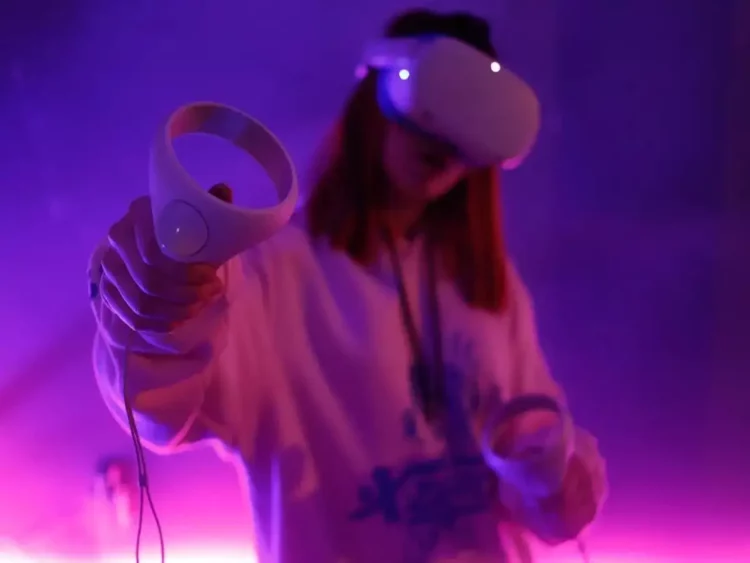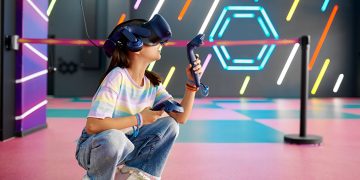Virtual reality (VR) is no longer a science fiction fantasy or niche technology; it has evolved into a transformative force across a wide variety of industries. Initially, VR was associated with gaming and entertainment, but today, its applications span education, healthcare, real estate, retail, military, and beyond. As the technology becomes more sophisticated, the line between the real and virtual worlds continues to blur, opening new possibilities for human interaction, creativity, and even cognitive enhancement.
In this article, we explore the journey of virtual reality, examining its history, technological breakthroughs, and how it is revolutionizing industries and everyday life. We will also consider the challenges and ethical considerations surrounding this rapidly developing field and look toward the future of VR as it moves beyond entertainment into a new era of immersive experiences.
The Origins of Virtual Reality
The concept of virtual reality can be traced back to the 1950s, well before the technology was ready for mainstream adoption. Early pioneers in VR research, such as Morton Heilig and Ivan Sutherland, created prototypes that laid the groundwork for what would become the VR technologies we know today.
Morton Heilig’s Sensorama: In 1962, Heilig, a filmmaker and inventor, developed a machine called the “Sensorama,” which was designed to simulate an immersive, multisensory experience. Although it wasn’t a fully immersive VR experience in the way we think of it today, Sensorama integrated visuals, sound, and even smell to create a more immersive film-watching experience. While not successful commercially, the concept of multisensory immersion would become a key principle in VR development.
Ivan Sutherland’s Sketchpad: In 1965, Ivan Sutherland, often regarded as the father of computer graphics, developed Sketchpad, an interactive graphics program that allowed users to draw on a computer screen using a light pen. This work laid the foundation for later developments in 3D graphics, which are essential for creating virtual environments.
The idea of head-mounted displays (HMDs) also emerged in this era. Sutherland’s creation of the first HMD, known as the “Sword of Damocles” in 1968, was a pivotal moment. While it was heavy, cumbersome, and lacked the visual clarity of modern VR devices, it demonstrated the potential of immersive virtual worlds.
Technological Advancements: From Concept to Reality
In the 1980s and 1990s, virtual reality made significant strides toward becoming a practical technology. However, early VR systems were often prohibitively expensive and required substantial computing power. Despite these barriers, the idea of virtual worlds continued to capture the imagination of developers, technologists, and consumers.
Advancements in Display Technology: The development of more powerful computer processors and displays was crucial for the progress of VR. In the 1990s, the introduction of more advanced CRT displays and the subsequent shift to liquid crystal display (LCD) and OLED technology dramatically improved the visual fidelity of VR experiences. Today’s VR headsets, such as the Oculus Quest 2 or HTC Vive Pro, feature high-definition, low-latency displays, which are vital for creating the illusion of an immersive environment.
Motion Tracking and Interaction: Early VR systems often relied on clunky controllers or basic input devices. However, the introduction of motion-tracking technology — using accelerometers, gyroscopes, and external sensors to track the movement of the user — was a game-changer. This technology, which allows the user to move through the virtual world naturally, is central to current VR applications. It also enables hand and body tracking, making the virtual experience feel even more real.
Wireless and Standalone VR Systems: The biggest shift in VR technology has been the move toward standalone, wireless VR headsets. The Oculus Quest series, for instance, removes the need for expensive external sensors or high-end computers, allowing anyone to set up and use a fully immersive VR system in minutes. With wireless VR, users are no longer tethered by cables, enhancing the sense of immersion and enabling greater freedom of movement.
Revolutionizing Industries with VR
While gaming and entertainment remain the most popular use cases for VR, the technology has proven to be transformative across numerous sectors. Below are some examples of how VR is reshaping industries and improving lives.

Healthcare
In the healthcare industry, VR is being used for everything from pain management to surgical training. For example, VR allows patients to engage in virtual environments that help reduce anxiety or manage chronic pain. Virtual reality exposure therapy (VRET) has shown promise in treating PTSD, phobias, and anxiety disorders by immersing patients in controlled virtual scenarios that gradually desensitize them to their triggers.
In surgical training, VR allows medical students to practice delicate procedures in a safe, virtual environment. Surgeons can also rehearse complex surgeries with 3D visualization, improving accuracy and reducing errors in real-life operations.
Education
Education is another area where VR has enormous potential. Imagine being able to take students on virtual field trips to historical sites, the human bloodstream, or even outer space. VR can bring abstract concepts to life, allowing students to interact with models, perform virtual experiments, or engage in real-world simulations.
Additionally, VR creates immersive learning environments for complex skills. For example, in medical education, students can practice surgeries or diagnose medical conditions using highly realistic virtual patients, all within a risk-free, simulated environment.
Real Estate and Architecture
Virtual reality has revolutionized the way people buy and design homes. VR real estate tours allow potential buyers to explore properties remotely, enabling them to experience a house or apartment as if they were physically present, without ever leaving their current location. This is especially useful for international buyers or in the current climate of remote work.
In architecture and urban planning, VR is used to create highly detailed virtual models of buildings and environments, allowing designers and clients to walk through structures before they are even built. This can help in fine-tuning designs and visualizing the impact of various choices.
Retail
In the retail industry, VR is being used to create virtual shopping experiences that allow customers to browse stores and products from the comfort of their own homes. This is particularly relevant in today’s e-commerce-driven world, where many consumers are seeking more interactive and personalized shopping experiences.
For example, IKEA offers a VR kitchen design tool that allows customers to visualize how their space will look with various layouts, color schemes, and furniture choices. These types of immersive experiences could reshape the way we shop, making it more engaging and informative.
Challenges and Ethical Considerations
As with any emerging technology, VR comes with its own set of challenges and ethical concerns. One of the main issues is the potential for motion sickness. VR sickness occurs when the user’s visual perception of movement doesn’t align with the physical sensations of their body. As the technology advances, developers are working on ways to reduce or eliminate these issues, such as by improving frame rates or creating more comfortable hardware.
Another challenge is the accessibility of VR systems. While standalone VR headsets have become more affordable, they still remain out of reach for many people, especially in developing countries. In addition, there are concerns about the psychological effects of prolonged VR usage, particularly in younger audiences. VR has the potential to be highly immersive, but we must be cautious about the potential for addiction, social isolation, or disconnection from the real world.
Privacy and data security are also key concerns. VR systems can gather sensitive data about users, such as their movements, gestures, and even biometric information. As VR continues to become more integrated into our daily lives, ensuring that these data are protected and used responsibly will be critical.
The Future of VR: A World of Endless Possibilities
Looking to the future, the possibilities for VR are virtually limitless. As the technology continues to evolve, we can expect even more immersive and interactive experiences. With advancements in AI, machine learning, and computer vision, VR could eventually lead to fully realized mixed-reality environments where the boundaries between physical and virtual worlds are indistinguishable.
Moreover, as 5G networks become more widespread, the ability to stream high-quality VR experiences in real-time will allow for an even greater level of interactivity. This will further enhance VR’s potential in gaming, social networking, and education.
Ultimately, the rise of virtual reality represents the beginning of a profound shift in how we experience and interact with the world around us. From gaming to healthcare, from education to social connection, VR is set to redefine the way we work, play, and learn in the years to come.












































